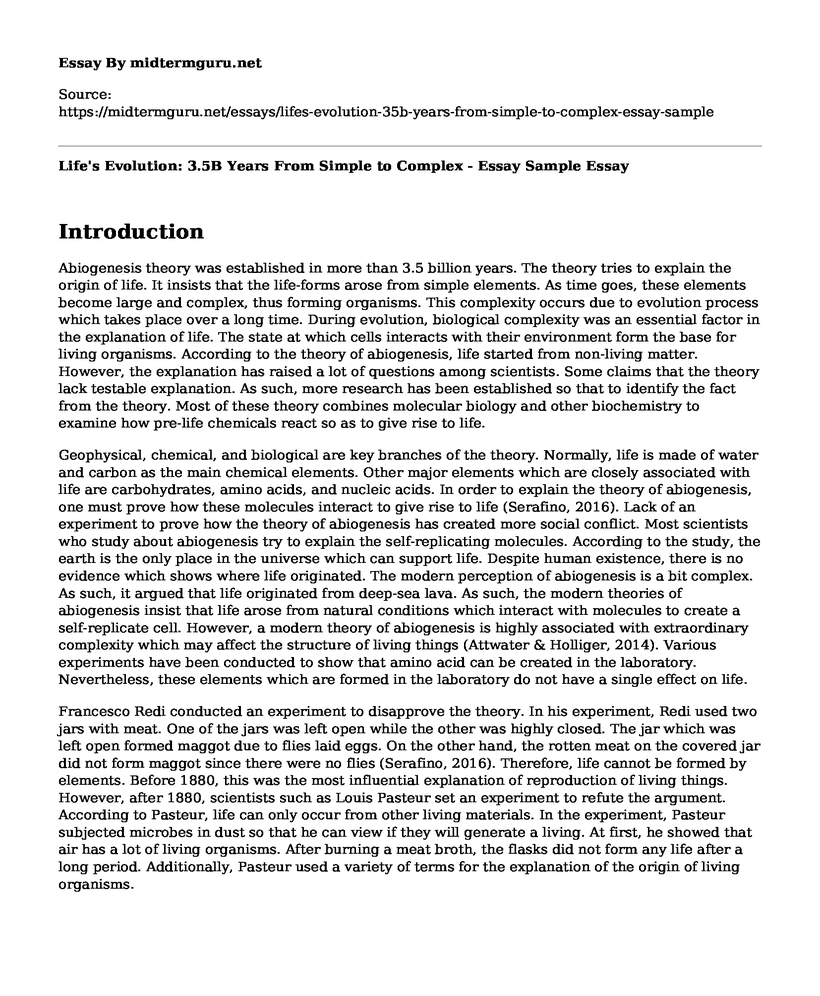Introduction
Abiogenesis theory was established in more than 3.5 billion years. The theory tries to explain the origin of life. It insists that the life-forms arose from simple elements. As time goes, these elements become large and complex, thus forming organisms. This complexity occurs due to evolution process which takes place over a long time. During evolution, biological complexity was an essential factor in the explanation of life. The state at which cells interacts with their environment form the base for living organisms. According to the theory of abiogenesis, life started from non-living matter. However, the explanation has raised a lot of questions among scientists. Some claims that the theory lack testable explanation. As such, more research has been established so that to identify the fact from the theory. Most of these theory combines molecular biology and other biochemistry to examine how pre-life chemicals react so as to give rise to life.
Geophysical, chemical, and biological are key branches of the theory. Normally, life is made of water and carbon as the main chemical elements. Other major elements which are closely associated with life are carbohydrates, amino acids, and nucleic acids. In order to explain the theory of abiogenesis, one must prove how these molecules interact to give rise to life (Serafino, 2016). Lack of an experiment to prove how the theory of abiogenesis has created more social conflict. Most scientists who study about abiogenesis try to explain the self-replicating molecules. According to the study, the earth is the only place in the universe which can support life. Despite human existence, there is no evidence which shows where life originated. The modern perception of abiogenesis is a bit complex. As such, it argued that life originated from deep-sea lava. As such, the modern theories of abiogenesis insist that life arose from natural conditions which interact with molecules to create a self-replicate cell. However, a modern theory of abiogenesis is highly associated with extraordinary complexity which may affect the structure of living things (Attwater & Holliger, 2014). Various experiments have been conducted to show that amino acid can be created in the laboratory. Nevertheless, these elements which are formed in the laboratory do not have a single effect on life.
Francesco Redi conducted an experiment to disapprove the theory. In his experiment, Redi used two jars with meat. One of the jars was left open while the other was highly closed. The jar which was left open formed maggot due to flies laid eggs. On the other hand, the rotten meat on the covered jar did not form maggot since there were no flies (Serafino, 2016). Therefore, life cannot be formed by elements. Before 1880, this was the most influential explanation of reproduction of living things. However, after 1880, scientists such as Louis Pasteur set an experiment to refute the argument. According to Pasteur, life can only occur from other living materials. In the experiment, Pasteur subjected microbes in dust so that he can view if they will generate a living. At first, he showed that air has a lot of living organisms. After burning a meat broth, the flasks did not form any life after a long period. Additionally, Pasteur used a variety of terms for the explanation of the origin of living organisms.
Conclusion
In conclusion, the abiogenesis theory has highly been opposed by many scientists. The theory lacks any testable method which can explain the origin of life. Scientists such as Redi and Pasteur have played a vital role in showing why the theory is not approved.
References
Attwater, J., & Holliger, P. (2014). A synthetic approach to abiogenesis. Nature methods, 11(5), 495.
Serafino, L. (2016). Abiogenesis as a theoretical challenge: Some reflections. Journal of theoretical biology, 402, 18-20.
Cite this page
Life's Evolution: 3.5B Years From Simple to Complex - Essay Sample. (2023, Jan 16). Retrieved from https://midtermguru.com/essays/lifes-evolution-35b-years-from-simple-to-complex-essay-sample
If you are the original author of this essay and no longer wish to have it published on the midtermguru.com website, please click below to request its removal:
- Essay Sample on Nuclear Warfare
- Paper Example on Hazard Controls and Solutions
- Recycling in Houston Is a Problem - Essay Example
- Differences Between a Healthy and an Unhealthy Brain - Essay Example
- Protecting Planet Earth: Conserve Natural Resources, Manage Waste - Essay Sample
- Computers: A New Way to Connect Human Brains - Essay Sample
- Myanmar Floods: A Continuous Crisis in the East - Essay Sample







